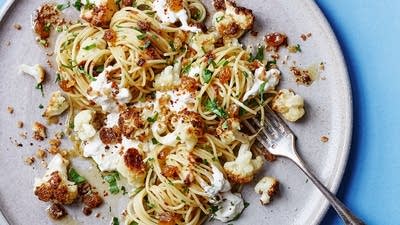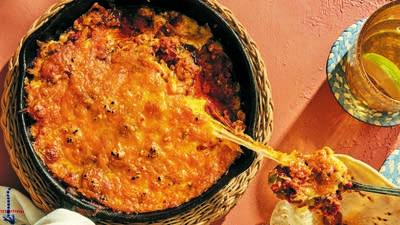Excerpted from Vegetarian Cooking for Everyone by Deborah Madison (10th anniversary edition, Broadway Books, 2007). Copyright 2007 by Deborah Madison.
Prep time:
Cook time:
Total time:
Yield: Serves 6
Lasagna is seldom fast to put together, but it's always just right for a weekend supper with friends and family. I adore winter squash, so when I wanted to use it in a lasagna, I started playing with it, adding walnuts for their texture and taste, and Gruyére cheese for the way it echoes the nuts. I keep the layering simple, but serve each square on a bed of garlicky black kale.
Serve this big handsome dish with an Old Vine Sonoma Zinfandel such as Ridge's Lytton Springs, or a Chianti Classico. Fonterutoli would be a good choice.
Begin with the béchamel sauce so that the milk can absorb the flavor of the aromatics, then turn to chopping the squash, onion, and herbs. While the squash is cooking, finish the sauce and compose the dish. You don't need to cook the kale until 30 minutes or so before serving.
From the November 17, 2007 episode.
Ingredients
The Béchamel Sauce:
3-1/2 cups milk
Aromatics: 1 garlic clove, a slice of onion, a bay leaf, a parsley sprig
3-1/2 tablespoons butter
3-1/2 tablespoon flour
Sea salt and pepper
The Squash and Noodles:
1 large butternut squash weighing 3 pounds or a little less
1 large onion, chopped in 1/2-inch squares
2 fat garlic cloves
20 or so fresh sage leaves (or 1-1/2 tablespoons dried)
1/2 cup packed parsley leaves
1 cup lightly toasted walnuts or hazelnuts, finely chopped
2 tablespoons olive oil
1 8-ounce package no-boil lasagna
1 cup grated Parmesan cheese
1 cup grated Gruyére cheese
The Black Kale (also known as cavalo nero or Tuscan kale):
3 bunches black kale, washed
2 tablespoons olive oil
2 garlic cloves, peeled and crushed
Pinch red pepper flakes
Sea salt
Instructions
The Béchamel Sauce
1. Slowly heat the milk with the aromatics. When it's nearly boiling, cover the pot and turn off the heat. Let it stand until the squash is finished cooking, then reheat it.
2. Melt the butter in a saucepan and stir in the flour. Pour the milk through a strainer into the roux, then whisk briskly. Turn the heat to low and cook, stirring occasionally until the sauce thickens and the flour is cooked, 15 to 20 minutes. Season with 1/2 teaspoon salt and pepper.
The Squash and Noodles
Butter or oil a 9 X 12-inch baking dish. Preheat the oven to 375 F.
1. Peel the squash and chop it into a rough dice about 1/2-inch across or less. Dice the onion and chop the garlic with the sage and parsley.
2. Heat the oil in a wide skillet or Dutch oven. Add the onion and squash and cook over high heat, stirring frequently, for about 15 minutes. Reduce the heat to medium and continue cooking, occasionally giving the pan a stir until the squash is fairly tender and caramelized in places, about 10 minutes. Add the garlic-herb mixture and the nuts. Cook a few minutes longer then turn off the heat. Season with salt and pepper to taste. Complete the sauce, if you haven't already.
3. Spread 1/2 cup of the sauce in the baking dish and lay 3 noodles over it. Cover with half the squash mixture, 1 cup of the sauce, and half the Gruyére and 1/3 of the Parmesan. Repeat, then add the third layer of noodles. Spread the remaining sauce over them and top with the remaining Parmesan. (At this point the lasagna can be baked, or it can be held until you're ready.) Tent it with foil, bake for 30 minutes, then remove the foil and continue baking until bubbly and golden, 20 minutes longer. Remove from the oven and let rest while you cook the kale.
The Black Kale (also known as cavalo nero or Tuscan kale)
1. Strip the kale leaves from their stems and cut them into 1/2-inch strips. Heat the oil in a skillet, add the garlic, and cook long enough for it to perfume the oil and turn pale gold, then add the pepper flakes and the kale. Season with a few pinches salt, toss in the pan to coat with the oil, then add 2 cups water. Lower the heat, cover the pan and cook until the leaves are tender, 12 to 20 minutes, depending on their toughness. Don't undercook it, though. Taste for salt.
Before you go...
Each week, The Splendid Table brings you stories that expand your world view, inspire you to try something new, and show how food connects us all. We rely on your generous support. For as little as $5 a month, you can have a lasting impact on The Splendid Table. And, when you donate, you’ll join a community of like-minded individuals who love good food, good conversation, and kitchen companionship. Show your love for The Splendid Table with a gift today.
Thank you for your support.
Donate today for as little as $5.00 a month. Your gift only takes a few minutes and has a lasting impact on The Splendid Table and you'll be welcomed into The Splendid Table Co-op.



